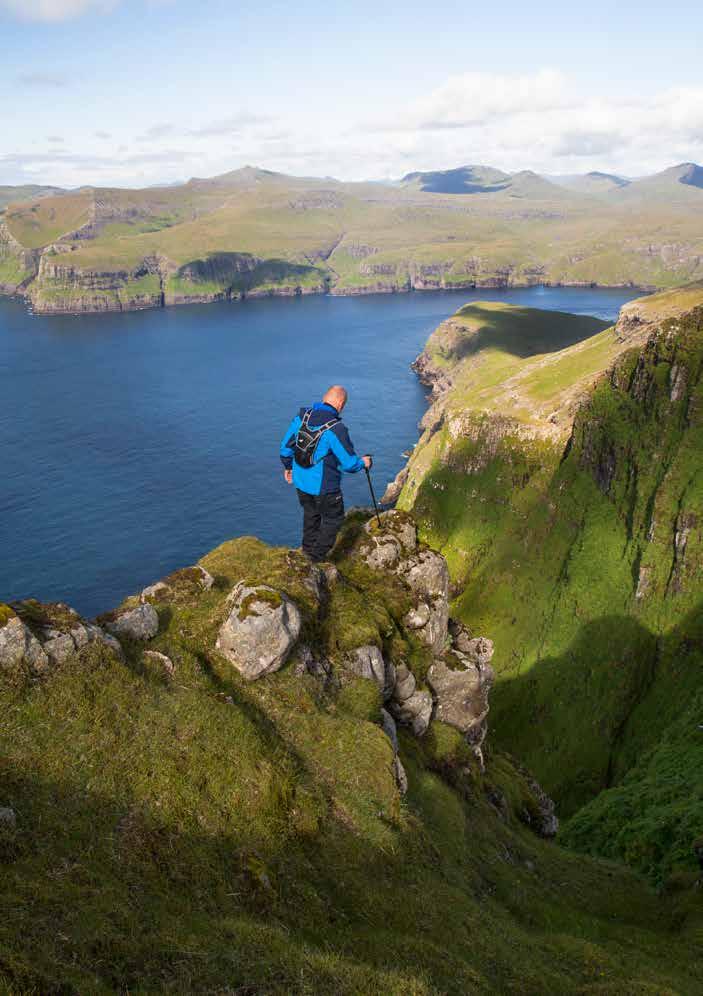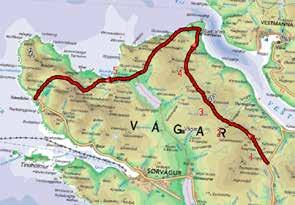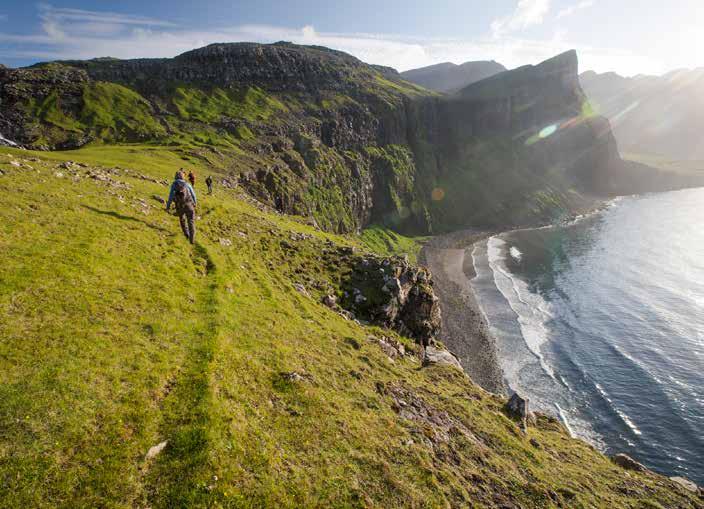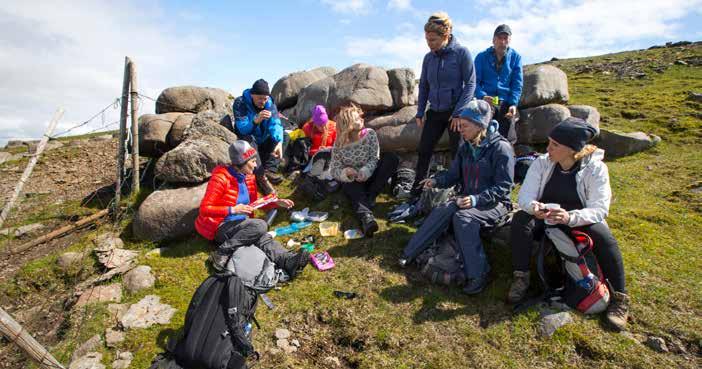
9 minute read
Bøur Gásadalur 13
Bøur Gásadalur
Hike along the old village path to the beautiful village of Gásadalur, which was one of the most isolated villages in the Faroe Islands until a few years ago

The route starts in the valley about three kilometres west of the village of Bøur. The path begins about one kilometre south (or left) of the tunnel entrance. You can see the path, which meanders up the Gásadalsbrekkan.
Gásadalur has been one of the most isolated villages in the Faroes. It is difficult to get to the village by sea and it was not until 2004 that the village was connected to the rest of the island by road when the tunnel was built. The people of Gásadalur used to walk this path when they had to go to the neighbouring villages to trade or for other errands. The helicopter service began in 1983.
The first stretch of the path is steep and runs close to the edge of the mountain . Therefore, walk extremely carefully, but do not forget to enjoy the outstanding view over Sørvágsfjørður, Tindhólmur, Gáshólmur and Mykines. In 2014, two men managed to climb all fives peaks of Tindhólmur.
There is no church in Gásadalur so the school is used for services. The cemetery is from 1873. Before then, people were burried in Bøur and so the coffin had to be carried over the mountain to Bøur from Gásadalur. The trip was very difficult and the only place that the bearers could rest was at the Líksteinurin (Corpse Stone), which you will come upon halfway through the route.
Further on, you come to the spring Vígdá . There is a story that a baby in Gásadalur became seriously ill and had to be taken to the doctor in Bøur. On the way to Bøur, the baby’s condition worsened and it was about to die. According to the Lutheran faith, your soul does not gain salvation if you die Duration: Two and a half hours (one way)
Distance: Three and a half km
Difficulty: Moderate to difficult. It is steep and difficult to climb Gásadalsbrekkan, and the descent to Gásadalur is also steep
Maximum height: 434 m
Children: Not suitable for children under eight to ten years, as the route is steep with many loose stones
Surface: Grass path. Down towards Gásadalur, path with stones and small rocks
Map: 210
Special comments: Be extra careful on the way down towards Gásadalur, as there are many loose stones, especially if you travel in a group
unbaptised. Therefore, the priest, who was travelling with them, quickly blessed the spring and baptised the baby.
When you continue, you will see Risasporið . There is a legend about two giants. One lived in Gásadalur and the other in Mykines. Once, they quarrelled and the Gásadalur giant wanted to go to Mykines to settle the dispute. He took running leaps along the mountain, took off, and with one leap, he landed on Mykines. He took off so hard that you can see his footprint to this day.
From Skarði, the path twists down the mountainside to the village. Beware of loose stones! The view down to Gásadalur is one of the most beautiful sights you can experience. The small, beautiful village is surrounded by green infield with harsh high mountains. One of them is Árnafjall, which, with its 722 metres, is the tallest mountain on Vágar.
In the village, there are ruins from the Middle Ages, called Uppi við Garð and Gæsutoftir.
Á Hálsi við Sandavág Slættanes Fjallavatn Gásadalur

Enjoy this adventurous route to some of the most beautiful pearls in the Faroe Islands

Á HÁLSI - SLÆTTANES
The route starts at the parking lot á Hálsi before Sandavágur (also called Sandavágshálsur). Go diagonally to the left toward the gorge called Ravnagjógv and follow the path uphill. Here, you will find the first cairn on the cairn path. This is the old path that connected the villages of Sandavágur and Slættanes. All traffic between the settlements took place on this path.
After one to two kilometres, the terrain evens out, and you have a good view over a large part of Streymoy, the villages of Skælingur, Leynar and Kvívík, and the southern mountains of Skælingur and Sátan. Soon, the charming village of Vestmanna appears on the other side of the fjord. For many years, Vestmanna was a hub for traffic to Vágar and the airport. A ferry sailed between Vestmanna and Oyrargjógv, but was replaced by a subsea tunnel in 2002, the first of its kind in the Faroe Islands.
After about five kilometres, another cairn path crosses the path . This is the path between Sørvágur and Oyrargjógv. Stay on your current route. It can be difficult to see the path and the next cairn in some places, but if you take your time, you will find them. By Fótamørsklettur, you will find a rather square stone next to the fence. This type of stone is called Hav. In ancient times, men used to compete by lifting the stone and seeing who was strongest. Be careful not to hurt your back if tempted to match your strength with the strong men of the Faroe Islands.
When you pass Tungufellið Lítla, the path separates into two . You must follow the lower of the cairns. The other is a horse path that leads into the Duration: 12-15 hours (one way)
Distance: About 28-30 km
Difficulty: Moderate to difficult. The first part of the route to Slættanes is on flat ground and then goes downhill. The stretch from Slættanes and to Skoradalshálsur is quite difficult. The trip from Reipsá to Gresskarð can also be a challenge
Maximum height: 625 m
Children: Because the trip is long, it is not suitable for small children. Children from 10-12 years of age can participate, but you could consider dividing the route in two to three stages
Surface: Grass path with cairns. In some places, rocks and stones
Maps: 210, 309 and 310
Special comments: Because the trip is long, it is important to bring a big packed lunch, water (2-3 litres) if you do not drink water from streams, and preferably something sweet. The nearest store is far away from the route. It’s a good idea to bring sandals to wade across the river at Fjallavatn. If you don’t have the courage to cover the hike in one stretch, consider staying the night in Vágar and continuing the following day. There is no phone coverage in many places on the trip
mountains. Follow the cairns down through Skáardalur and soon you arrive in Slættanes.
There are a few houses in Slættanes, but they are usually empty because the village is uninhabited. The settlement has only been inhabited for a period of around one hundred years. A family moved to Slættanes in 1835 and spent the first five years alone in this desolate place. Others then arrived, and in 1940, 75 people lived in Slættanes. Sometimes there were even more people. In 1964, the last inhabitants of the village left.

SLÆTTANES - FJALLAVATN
From Slættanes you move up to Skoradalshálsur. You will find the path by the end of the road above the village. Follow the cairns uphill towards Skoradalshálsur.
On Skoradalshálsur you have a stunning view to the north of Streymoy, including the famous Vestmanna bird cliffs and Snubburnar, which - with its very sharp and steep shape - is one of the most beautiful mountains in the Faroe Islands. Here, you are at the threshold of some of the most beautiful places that Vágar has to offer.
Follow the path down to Reipsá, which is the river from the north end of Fjallavatn. The lake is the second largest lake in the Faroe Islands. The largest, Leitisvatn (also called Sørvágsvatn and Vatnið), is also on the island of Vágar. From Skoradalshálsur you can choose a more offroad route down to Reipsá. You can walk towards the mountains in the north (on your right), follow the ridge westwards and then get back on the path again by Reipsá. The view is unique over the green hills and blue sea. However, be careful, as the terrain is very steep and there are some gorges, and the area downhill towards Reipsá is quite rocky and uneven.
FJALLAVATN - GÁSADALUR
It can be difficult to cross Reipsá without getting your feet wet, but try to find a place where the river runs slower. You cross Gullringsá, which is the stream that runs down the mountainside on the left.
Before going up, you must remember to glance towards Víkar , which is another uninhabited village. It was founded in 1833, but was abandoned in 1932. The settlement is indeed very remote, since the
distance to the nearest village is about two hours on foot and in difficult terrain. The area is incredibly beautiful with the small beach in the hook, the green carpet of grass and steep Árnafjall towering over the area.
Follow the path diagonally uphill towards the mountain wall. It can be a little confusing here because it can look like there are several paths. But when you get further uphill and westwards, you will see the path that goes through Kálvarók more clearly. Beware of slippery rocks in some places on the way up. Follow the cairns through Jøkladalur and Kjógvadalur. Then you come up to Gresskarðadalur. Here, the path is difficult to see. Walk in the green area under the rock wall on your right-hand side and head for the green area up by Gresskarð at the end of the valley.
From Gresskarð, located at approximately 630 metre altitude, you have clear view of Árnafjall, which is the highest mountain on Vágar. Right above you is Eysturtindur, which is the second-highest mountain on the island. This place is perfect for a coffee break and to enjoy the colours of the evening sun on the surrounding mountains. The descent to Gásadalur is quite rocky and it can be difficult to discern the path. But go down through the rocky area, and when you get further down, you can spot a trail that runs from the edge and down the valley. In recent years, the path has been expanded to a road for vehicles. Moving further downhill, you spot the small village of Gásadalur, which is located in the valley by the sea. The closer you get, the more you’ll understand why Gásadalur is many photographers’ favourite site. The settlement is unique and fascinating no matter which angle it is viewed from. Gásadalur has been one of the most isolated villages in the Faroes. Until a tunnel was built in 2004, the village could only be reached by walking along a steep mountain path south of the village, or by helicopter service, which started flying to Gásadalur in 1983.
There are several explanations for the name Gásadalur (Goose Valley). Tradition says that the name is related to Gæsa, a woman from Kirkjubøur. She had eaten meat during Lent, which was forbidden. As punishment, she lost all her property and moved to the valley, which was named after her. Another explanation for the name is that it comes from wild geese that used to live in the valley during the summer.











